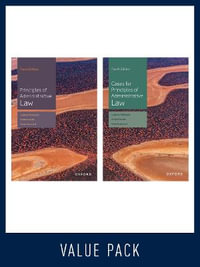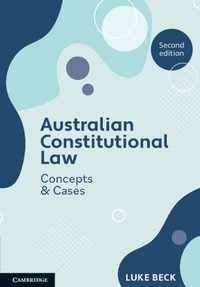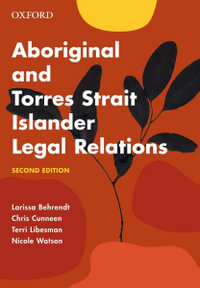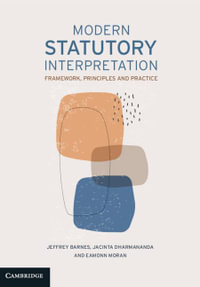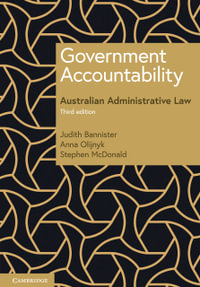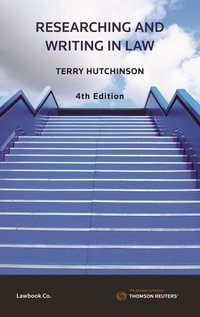
At a Glance
Paperback
RRP $69.99
$56.75
19%OFF
or
Available: 7th August 2025
Preorder. Will ship when available.
This book sets out the structure and principles of administrative law in Aotearoa New Zealand. It identifies underlying tensions between often competing objectives, and outlines current trends and debates and presents a unified account of administrative law as a whole, beyond judicial review. Given the recent recognition of tikanga - Maori customary law - as part of the laws of Aotearoa New Zealand, this book also offers tentative explorations of the roles tikanga may come to play in administrative law.
Part One outlines the nature of administrative law and judicial review and how they fit together, as well as how administrative law relates to constitutional law and political accountability. It outlines what and who is the public administration, the various sources of legally relevant norms that apply to it, and its various accountability institutions and mechanisms. It introduces debates about the shape of administrative law as a whole, and about the appropriate scope of judicial review within this. It outlines the influence of competing political values and constitutional norms in those debates.
Part Two analyses the administrative law norms governing the conduct of public administration that are found in the grounds of judicial review. The four chapters are devoted to procedural fairness grounds, illegality grounds, modern rights-based review and other modern extensions of substantive review.
Part Three examines availability, including justiciability and the approach to privative clauses purporting to exclude or restrict access to judicial review. It asks whether we could adopt a better framework for calibrating judicial restraint than the current approach particularly to questions of law. Finally it explores judicial review remedies and other public law judicial remedies, with a focus is on the characteristic limits of those remedies.
Part Four looks the public nature test that determines the extent to which public law constraints apply to partly private decisions or public decision of partly private bodies, before considering the extent to which private law applies to officials or authorities exercising public powers.
Part Five explores the administrative justice literature, debating the design and evaluation of institutions for making and for challenging public administrative decisions. It looks at frontline decision-making and concerns remedial avenues.
Part One outlines the nature of administrative law and judicial review and how they fit together, as well as how administrative law relates to constitutional law and political accountability. It outlines what and who is the public administration, the various sources of legally relevant norms that apply to it, and its various accountability institutions and mechanisms. It introduces debates about the shape of administrative law as a whole, and about the appropriate scope of judicial review within this. It outlines the influence of competing political values and constitutional norms in those debates.
Part Two analyses the administrative law norms governing the conduct of public administration that are found in the grounds of judicial review. The four chapters are devoted to procedural fairness grounds, illegality grounds, modern rights-based review and other modern extensions of substantive review.
Part Three examines availability, including justiciability and the approach to privative clauses purporting to exclude or restrict access to judicial review. It asks whether we could adopt a better framework for calibrating judicial restraint than the current approach particularly to questions of law. Finally it explores judicial review remedies and other public law judicial remedies, with a focus is on the characteristic limits of those remedies.
Part Four looks the public nature test that determines the extent to which public law constraints apply to partly private decisions or public decision of partly private bodies, before considering the extent to which private law applies to officials or authorities exercising public powers.
Part Five explores the administrative justice literature, debating the design and evaluation of institutions for making and for challenging public administrative decisions. It looks at frontline decision-making and concerns remedial avenues.
ISBN: 9781509930906
ISBN-10: 1509930906
Available: 7th August 2025
Format: Paperback
Language: English
Number of Pages: 352
Audience: College, Tertiary and University
Publisher: Bloomsbury Publishing (AUS)
Country of Publication: GB
Dimensions (cm): 24.4 x 16.9
Shipping
| Standard Shipping | Express Shipping | |
|---|---|---|
| Metro postcodes: | $9.99 | $14.95 |
| Regional postcodes: | $9.99 | $14.95 |
| Rural postcodes: | $9.99 | $14.95 |
How to return your order
At Booktopia, we offer hassle-free returns in accordance with our returns policy. If you wish to return an item, please get in touch with Booktopia Customer Care.
Additional postage charges may be applicable.
Defective items
If there is a problem with any of the items received for your order then the Booktopia Customer Care team is ready to assist you.
For more info please visit our Help Centre.


